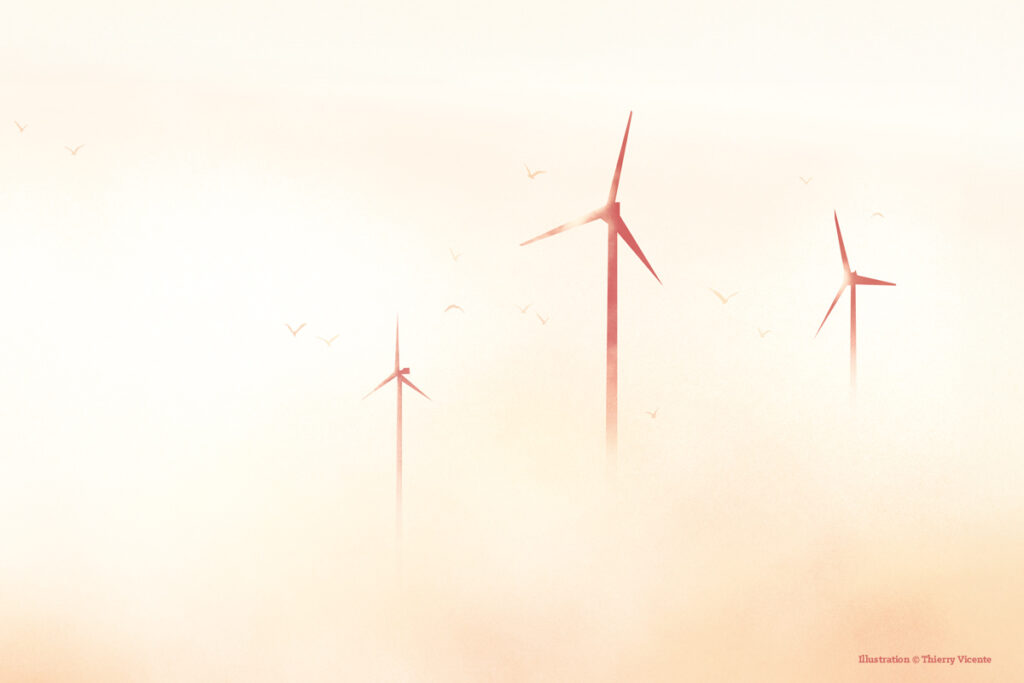[LUM#19] Stolen Lives
Every year in France, tens of thousands of birds are killed in mid-flight by wind turbine blades. Faced with this high mortality rate and with the French government planning to double its wind farm capacity, the MAPE program MAPE brings together private and public stakeholders to ensure that wind power does not blow these wind-dependent communities away.

On the morning of January 16, a golden eagle was found dead at the foot of a wind turbine at the Bernagues site in Hérault (France 3, January 27, 2023). The extent of bird mortality attributable to wind turbines remains unclear, with "the figure currently circulating being seven deaths per year per wind turbine in France. This figure is probably lower than the actual number and, above all, does not distinguish between species. However, birds of prey that need the wind to move around are competing for space with wind turbines," explain Olivier Duriez and Aurélien Besnard, biologists at the Center for Functional and Evolutionary Ecology in Montpellier* and scientific leaders of the MAPE (Bird Mortality in Wind Farms) project.
Launched in 2019 on the initiative of Dreal Occitanie and the League for the Protection of Birds (LPO) with the Maison des Sciences de l'Homme, MAPE brings together a consortium of public and private actors, including 25 wind farm operators, to reduce this bird mortality. In response to societal expectations, more and more wind farms are equipping their turbines with automatic detection systems (ADS) that can shut down the blades when a bird approaches. "The first step was to offer operators a scientific protocol to evaluate the effectiveness of these systems, on which there are almost no studies," explains Aurélien Besnard. Even in wind farms equipped with ADS, collisions continue to be reported.
Theft detector
To better adjust these SDA settings, researchers have also developed EolDist. This free online application calculates the minimum distances required to detect a bird by cross-referencing, using an integrated database, the speed and type of flight according to species with meteorological data and the machine's stopping time. "If I take the golden eagle, which flies at an average speed of 15 meters per second, and if the wind turbine takes 41 seconds to stop, our eagle will need to be detected at 875 meters to avoid collision," explains Olivier Duriez. Although tests have been carried out, more are needed to improve the robustness of the application, but operators are reluctant to carry them out. "Eoldist's results tend to call into question the very logic of these detection systems," notes Aurélien Besnard. " If wind turbines stop every time a bird passes within 500 meters, they will stop all the time, which in itself is the best way to avoid bird mortality, but is not economically viable."
At the same time, researchers are also working on the effect of environmental conditions on collision risks: "Can fog, rain, and wind increase the likelihood of collisions? Does the terrain play a role?" asks Olivier Duriez. They are exploring these avenues by analyzing videos of collisions filmed by wind turbine cameras. "Having operators in the consortium gives us access to these images, which remain fairly sensitive data for the wind farms." The results could help improve the selection of wind farm sites and adapt their operation when weather conditions are conducive to collisions.
Feathered populations
Another objective of the MAPE program is to raise awareness of biodiversity issues by developing EolPop, a simple application for calculating the impact of mortality on the population dynamics of a species. "Losing an eagle or a chickadee does not have the same consequences in terms of the long-term viability of the population," warns Olivier Duriez. EolPop allows its users, whether wind farm operators or nature conservation associations, to cross-reference survival and fertility values for each species with data on population size. "The approach we have chosen is to compare the population sizes we would have in 30 years with and without the wind farm."
Let's take the case of the golden eagle again: with an annual mortality rate for a population of ten pairs, the population will become extinct in less than 30 years. "Fortunately, not all species are affected to the same extent, but this allows us to be objective," continues the researcher. Today, some research firms say that one eagle per year is not a lot. But not a lot compared to what? Here we have figures based on robust calculations," adds Aurélien Besnard. These figures shed a rather grim light on others: France currently has 8,000 onshore wind turbines and plans to double its fleet by 2028. Wind power has a bright future, but the golden eagle does not.
Bird's-eye views
Why do these collisions between birds and wind turbines occur? To understand this, research is being conducted as part of MAPE on birds' vision and, more specifically, their level of contrast perception. In other words, are they able to distinguish a wind turbine against a gray sky? "The doctoral student conducting this research has carried out tests on 35 species of birds. The result is that they have a contrast vision between 7 and 30 times lower than ours," explains Olivier Duriez. The same is true for the perception of rotational movement, which seems to be weaker in birds. "At high speeds, the buzzards and doves tested detect rotation very well, but below three or five rotations per minute, perception becomes much more difficult," continues the researcher. This information could enable wind farm operators to adapt turbine speeds to birds' vision. In Norway, some wind farms are attempting to improve contrast by painting one blade of each wind turbine black (France Inter , August 29, 2020). However, the effectiveness of this method has been mixed.
*Cefe (CNRS, UM, IRD, EPHE, INRAE, Institut Agro, UPVM)
Find UM podcasts now available on your favorite platform (Spotify, Deezer, Apple Podcasts, Amazon Music, etc.).